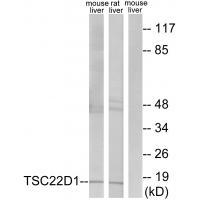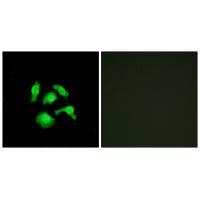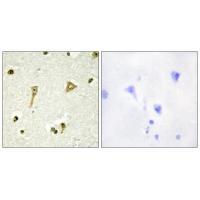


| WB | 咨询技术 | Human,Mouse,Rat |
| IF | 咨询技术 | Human,Mouse,Rat |
| IHC | 1/50-1/100 | Human,Mouse,Rat |
| ICC | 1/100-1/500 | Human,Mouse,Rat |
| FCM | 咨询技术 | Human,Mouse,Rat |
| Elisa | 咨询技术 | Human,Mouse,Rat |
| Aliases | TGFB-stimulated clone 22; TGFB1I4; TSC22; cerebral protein 2; regulatory protein TSC-22 |
| Entrez GeneID | 8848; |
| WB Predicted band size | 16kDa |
| Host/Isotype | Rabbit IgG |
| Antibody Type | Primary antibody |
| Storage | Store at 4°C short term. Aliquot and store at -20°C long term. Avoid freeze/thaw cycles. |
| Species Reactivity | Human,Mouse,Rat |
| Immunogen | Synthesized peptide derived from internal of human TSC22D1. |
| Formulation | Purified antibody in PBS with 0.05% sodium azide. |
+ +
以下是关于TSC22D1抗体的示例参考文献(信息为示例性总结,建议通过学术数据库核实具体文献):
---
1. **"TSC22D1 suppresses tumor growth and metastasis in gastric cancer"**
- **作者**: Kawauchi et al.
- **摘要**: 研究通过Western blot和免疫组化使用TSC22D1抗体,发现该蛋白在胃癌组织中表达下调,且与患者预后相关。实验表明TSC22D1通过调控TGF-β信号通路抑制肿瘤侵袭。
2. **"TSC22D1 regulates renal fibrosis via modulating ECM deposition"**
- **作者**: Zhang et al.
- **摘要**: 利用TSC22D1特异性抗体在小鼠肾脏纤维化模型中发现,TSC22D1通过抑制胶原蛋白合成关键基因表达,减轻纤维化进程,抗体用于组织染色和蛋白质互作分析。
3. **"Stress-induced TSC22D1 nuclear translocation in neuronal cells"**
- **作者**: Oshiro et al.
- **摘要**: 研究采用TSC22D1抗体验证其在氧化应激下的亚细胞定位变化,揭示其通过结合转录因子调控应激相关基因,抗体用于免疫荧光和ChIP实验。
4. **"TSC22D1 as a novel immune checkpoint in T-cell activation"**
- **作者**: Müller et al.
- **摘要**: 通过流式细胞术和Co-IP实验(使用TSC22D1抗体),发现该蛋白负向调控T细胞受体信号通路,可能成为自身免疫疾病治疗靶点。
---
建议通过PubMed或Google Scholar以关键词“TSC22D1 antibody application”或“TSC22D1 protein function”检索最新文献,或查阅抗体供应商(如Santa Cruz、Abcam)提供的引用文献列表。
The TSC22D1 antibody is a research tool used to detect the TSC22 domain family protein 1 (TSC22D1), a ubiquitously expressed protein encoded by the TSC22D1 gene. TSC22D1 belongs to the TSC22D family of leucine zipper transcription factors and is implicated in cellular processes like proliferation, differentiation, and apoptosis. Structurally, it contains a conserved T-box domain critical for DNA binding and protein interactions. Functionally, TSC22D1 acts as a transcriptional regulator, influencing pathways such as TGF-β, MAPK, and glucocorticoid signaling. Its role in stress response, tumor suppression (e.g., inhibiting epithelial-mesenchymal transition in cancers), and fibrotic diseases has drawn significant research interest.
The antibody is widely used in techniques like Western blotting, immunohistochemistry, and immunofluorescence to study TSC22D1 expression, localization, and interactions. Commercially available antibodies are typically raised against specific epitopes, with polyclonal versions offering broad reactivity and monoclonal variants ensuring specificity. However, challenges persist, including cross-reactivity with TSC22D family isoforms (e.g., TSC22D2-4) and variability due to alternative splicing. Researchers must validate antibody specificity using knockout controls or siRNA. Recent studies highlight TSC22D1's dual roles—acting as a tumor suppressor in some contexts while promoting fibrosis in others—underscoring the antibody's utility in exploring its context-dependent mechanisms in disease models.
×